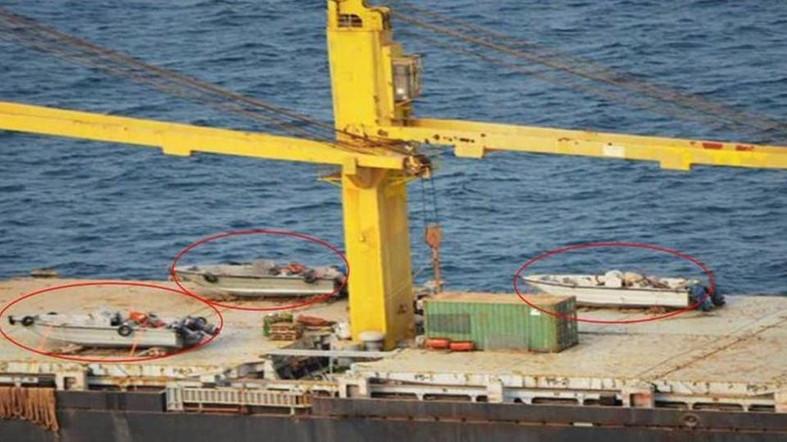Trump to sanction Iranian ship for facilitating terror strikes in Red Sea

Alarabiya
The Trump administration will take action against an Iranian ship that has been stationed at a key choke point in the Red Sea for months and is believed to be providing significant military and logistic aid to the Houthi militias Yemen.
Washington Free Beacon website quoted on Tuesday US officials and military experts familiar with the situation as saying that the ship which is identified as “Saviz” is an Iranian ship believed to be masked as a cargo vessel has been identified as the “mother ship” stationed in the Red Sea providing targeting information for Houthi anti-ship attacks, which have increased in recent months, including a late July attack by Iranian-backed rebels on a Saudi oil tanker.
The ship was delisted from US sanctions by the Obama administration as part of its efforts to uphold the landmark nuclear deal with Iran, US officials confirmed to the Washington Free Beacon.
Upcoming Trump administration action against the Saviz and other Iranian vessels is part of a broader package of sanctions expected to kick back in on November 5, officials confirmed.
Sanctions will target Iran’s port operations, shipping and shipbuilding sectors, and other affiliates.
Saviz aids Houthi militias’ boats
The Iranian ship “Saviz” , which has been anchored for more than a year in the Red Sea, near the Straits of Bab al-Mandeb in international waters, according to satellite shows, where the ship, which has been carrying commercial containers officially, since mid-2017.
Following the comments by the Iranian Revolutionary Guards Commander Nasser Shabani on the commanding of the Houthi militias to strike two Saudi oil tankers near Bab al-Mandab, observers highlighted Iran’s role in threatening the navigation of the Red Sea through this sophisticated radar-equipped vessel and boats equipped with guns to guide militia boats.
Iranian Revolutionary Guards Commander Nasser Shabani. (Supplied)
According to Iranian news outlets, many of the weapons handed over by the Iranian regime to the Houthi militias were carried out by speedboats from the same vessel. The boats were equipped with 23 mm ZU guns.
Saviz itself is equipped with a radar rarely seen on cargo ships, but used to steer the Houthi militias’ boats when attacking Saudi oil tankers.
The commander of the Quds Force of the Iranian Revolutionary Guards, Qasim Suleimani, said that “the Red Sea is no longer safe,” referring to the attack by the Houthi militias, backed by Tehran, an attack on two Saudi oil tankers, indicating Iran’s involvement directly, threatening the navigation in the Red Sea by instructing their Houthi militias to attack tankers.
US officials familiar with the Saviz’s actions in the Red Sea told the Free Beacon the Iranian vessel is barely attempting to obfuscate its military role in aiding Houthi rebels in Yemen.
“The Iranians aren’t even trying to disguise the military use of the ship,” said one US official familiar, who was not authorized to speak on record about the situation. “You don’t need classified intelligence or satellite photos of the decks to know that merchant ships simply don’t act this way.”
“If you’re moving goods, you don’t anchor in the same place for weeks at a time, let alone outside a war zone, let alone a war zone where militias are firing missiles at other ships,” the source said. “The Obama administration enabled the Saviz to sail globally. President Trump will put a stop to that.”
The Iranian ship’s suspicious activities have been cited in recent months by US military experts and foreign governments, including the Saudi government, which has been targeted by the Iranian-backed Houthi rebels.
“A ship like Saviz could carry [Iranian military] Qods Force command and control elements and host berthing and logistics, while controlling the activities of smaller, lower-profile craft,” according to J.E. Dyer, a retired Naval intelligence officier who recently published a lengthy analysis on the ship. “The maritime problem in a chokepoint is short-legged but very multifaceted. It’s time to get the sanctions game face back on, and pay Saviz or her sister ships a visit with a US cruiser or destroyer.”
Military use of a commercial vessel
For their part, US officials familiar with the movements of the ship “Saviz” in the Red Sea, told the Washington Free Beacon “It is certainly that the Iranian ship provides logistical support for the Houthis in Yemen.”
An American official said “The Iranians are not even trying to hide the military use of the commercial ship.”
US defense experts with the Washington Institute for Near East Policy, or WINEP, also have cited the Saviz as providing potential support and logistics to Houthi rebels as they commit acts of terrorism in the region.
WINEP’s experts have advocated that the Trump administration “direct more intelligence gathering against the Iranian ‘mothership’ Saviz, a cargo vessel moored off the Red Sea archipelago of Dahlak.”
“The Iranian military is likely using the Saviz to provide targeting data for Houthi anti-shipping attacks,” according to WINEP.
“Closer observation of the vessel and the threat of exposing its suspected intelligence role might be enough to make it leave the area. Alternatively, if authorities are able to prove its complicity in military activities, they may have a case for boarding and seizing it, which could yield further evidence that Iran is violating UN sanctions and supporting attacks on civilian vessels.”
The Saudi government has been tracking the Saviz for more than a year and has documented its extended stay in the Red Sea, activity usual for a typical cargo ship.
“Saviz appears to have remained there for extended periods in the months since,” Dyer noted in her analysis.
“This is not the typical profile of a large, modern, ocean-going cargo ship, which would be expensively ill-employed lingering among islands in the southern Red Sea.”
US officials confirm the Obama administration removed sanctions on the Saviz in January 2016, enabling its free travel across the region.
Sanctions were lifted as part of US commitments agreed upon under the nuclear deal, which President Donald Trump recently abandoned, paving the way for new economic sanctions on Tehran.
The Saviz is just one of numerous Iran-related vessels that received a pass from US sanctions in 2016.
Sanctions on the Saviz and other Iranian vessels are set to be re-imposed by November 5, according to information published by the Treasury Department.
US military officials with Central Command, or Centcom, which controls American operations in the region, declined Free Beacon requests for information on the Saviz and its operations.
Latest News
 Prime minister directs government to support IEC ahead of upcoming elections
Prime minister directs government to support IEC ahead of upcoming elections Parliamentary elections for 20th Lower House to be held on September 10 – IEC
Parliamentary elections for 20th Lower House to be held on September 10 – IEC Amman Chamber of Commerce says GDP grows by 4.4% in 2023
Amman Chamber of Commerce says GDP grows by 4.4% in 2023 King orders holding parliamentary elections in accordance with law, checks on electoral commission’s preparations
King orders holding parliamentary elections in accordance with law, checks on electoral commission’s preparations- N. Macedonia starts elections that could decide stalled EU talks
Most Read Articles
- Palestinian prime minister, Jordanian ambassador discuss humanitarian efforts in Palestine
- US president signs bill to provide new aid for Ukraine
- Prime minister directs government to support IEC ahead of upcoming elections
- Senate president, Rwanda’s ambassador discuss bilateral relations
- 'Sinwar Above Ground': Hamas official's revelation shocks Israeli Occupation
- Iran cuts Syria presence after strikes blamed on Israel —monitor
- US Supreme Court seems split on Idaho abortion ban
- Vaccines saved at least 154 million lives in 50 years — WHO
- Four dead as floods wreak havoc in Kenyan capital
- Germany nudges up growth forecast, ailing economy at 'turning point'